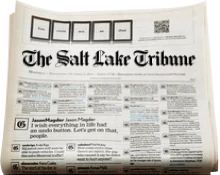This is an archived article that was published on sltrib.com in 2011, and information in the article may be outdated. It is provided only for personal research purposes and may not be reprinted.
Different political body in Salt Lake City, same tough sledding for Walmart.
The City Council didn't completely tip its voting hand, but members grilled the retail giant nonetheless for two hours Tuesday, suggesting Walmart's rezone request to place a scaled-back super center at 2705 E. Parleys Way will be a tough sell.
No decision will be made until after an Aug. 23 public hearing. Walmart was twice denied by the Planning Commission to erect a super center on the Parleys site. It has owned the property where a vacant Kmart sits since 2005.
Appealing in a sense to the council, Walmart stressed its energy-efficient 92,000-square-foot version — not a 120,000-square-foot behemoth — should be attractive to the east-bench community.
Council members, especially Soren Simonsen, who recently met with Walmart executives in Bentonville, Ark., did not necessarily agree.
"I'm really struggling to reconcile what I heard from your CEO, which is what this company is really about, and what we're being presented," Simonsen said. "It's something that I've found very discouraging."
Council members questioned the impact on traffic, the "suburbanization" effect, and doubted the retailer could design a store that promotes walkability.
"Would a big-box store here get in the way of other kinds of development?" asked Councilman Luke Garrott. "That's where my worry lies."
Councilman J.T. Martin also scolded the mega-retailer for removing the ZIP codes off so-called "scorecards" that Walmart representatives handed to residents across the city to gauge support.
"This is a community issue," Martin said. "And I would like to know where these people are from."
Walmart needs to secure four council votes for the rezone or resort to plan B. That alternative, according to Walmart spokeswoman Delia Garcia, is to put its super center in the abandoned Kmart, albeit with a limited remodel.
"Salt Lake City has demonstrated that rezoning is an effective tool for positive city planning," Garcia said. "We're looking at how to make it as small as possible."
Garcia insists the smaller model is innovative and sustainable. She says the company is talking to the Utah Transit Authority about transit connections to a new store. Plus the smaller store would reduce traffic by 24 percent, she stressed, making it less busy than Sugar House Commons.
Despite suggestions that residents would prefer a shopping center akin to Sugar House Commons, Carlton Christensen questioned whether the area has the residential density or walkability to zone it neighborhood commercial. "Frankly," he said, "the neighborhoods around there are about as auto-oriented as any in the city."
If the rezone is approved, Walmart's design plan must go back before the Planning Commission — under a full public process — for approval. Walmart hopes to open a store one way or the other by late 2012.
"We're caught in a dilemma because we don't have a very up-to-date plan for the area," explained planning director Wilf Sommerkorn. "We don't have any clear guidance."
Residents will have to wait at least a month to see if the council takes any guidance from the Planning Commission.
What's next?
P The City Council agreed to set Aug. 23 as the public hearing date for Walmart's rezone and master-plan amendment request. The council could vote on the request that night or at a future meeting. —
Leonardo gets $600,000 loan
In unanimous fashion, the council approved a $600,000 loan from the revolving loan fund for businesses for The Leonardo, a nonprofit "sci-tech art center" planned at the former Main Library on Library Square.
The new museum, originally set to open in April, requested the money to cover operating expenses associated with a six-month delay in opening. The city blames the delay on "contractor performance" and intends to assess damages of up to $300,000 on general contractor Ascent Construction. "It is pending," Public Works director Rick Graham told the council. "We believe that there will be liquidated damages."
That money would help defray the amount of the loan.
Ascent denies it is responsible for construction delays and says the April deadlines were met. The dispute could land in court.
The loan must be repaid within 10 years, and if Leonardo defaults, terms call for the museum to vacate the building.
"We're very happy for the city and council support," said Leonardo spokeswoman Lisa Davis, "and we look forward to a successful opening." —
In other city business
By unanimous vote, the council approved a false and nuisance fire alarm ordinance, which establishes set fees to defray the city's cost of responding to a business' false fire alarm.

